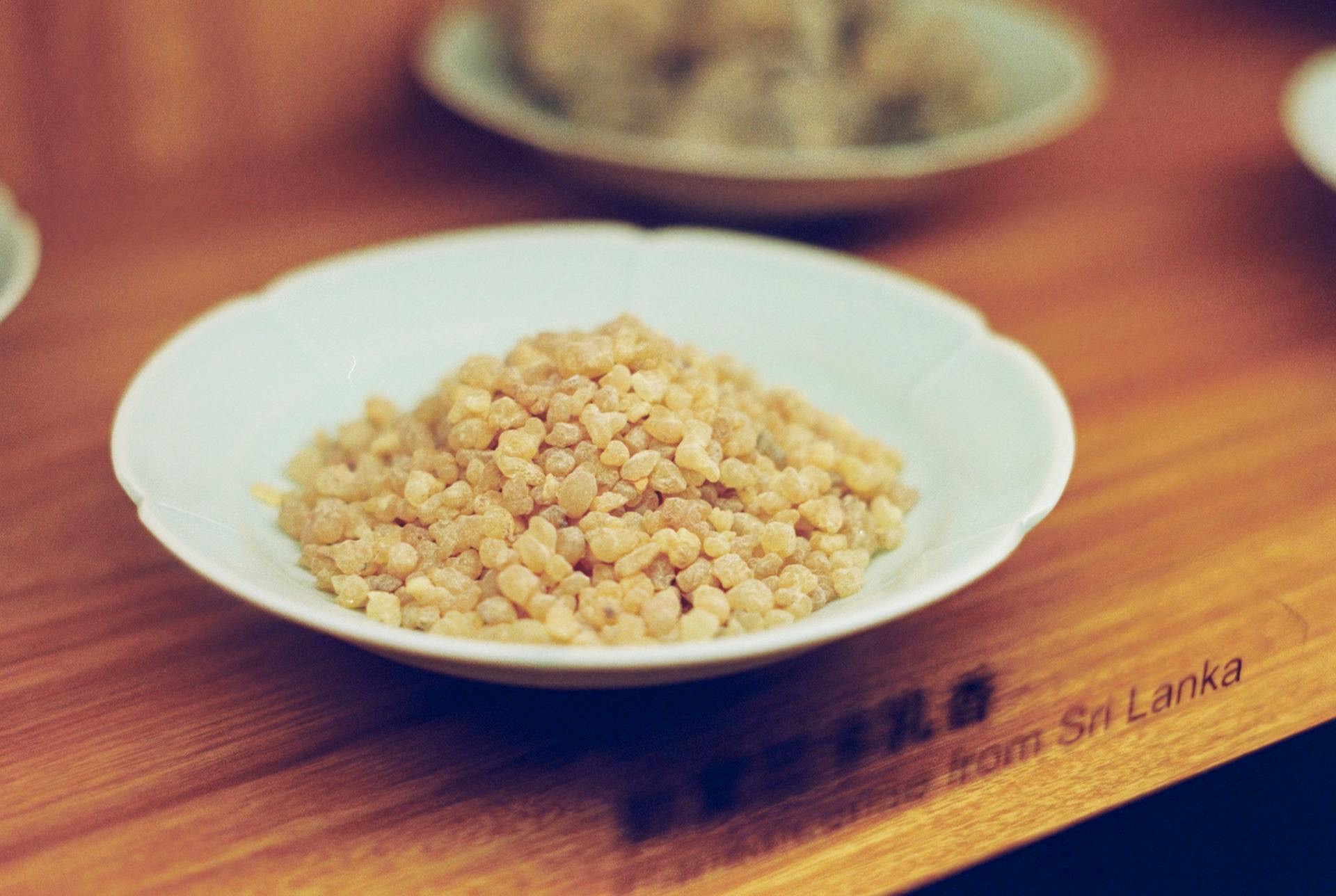Botanical Basics
- Common Name(s): Frankincense
- Folk Name(s): Olibanum, Incense, Lubān (Arabic), Kundur (Hindi)
- Scientific/Latin Name: Boswellia sacra (most valued), Boswellia serrata, Boswellia carterii, Boswellia frereana (other species used)
- Family: Burseraceae
- Plant Type: Small deciduous tree/shrub
- Botanical Description: 10–20 ft tall with papery bark, knotted branches, and pinnate leaves. Produces clusters of small white-yellow flowers. Resin is tapped from incisions in the bark, hardening into pale yellow, amber, or golden tears.
- Growing Zones/Climate: USDA Zones 10–12
- Best Zones for Growth: Arid, desert climates with limestone-rich soil
- Habitat & Range: Native to the Arabian Peninsula (Oman, Yemen) and the Horn of Africa (Somalia, Ethiopia); also in India
Cultivation & Harvest
- Soil & Sun Requirements: Dry, rocky, well-drained soil; full sun; thrives on limestone and cliffside habitats
- Propagation: By seed (difficult) or cuttings; grown mainly in arid agroforestry systems
- Companion Planting: Rarely intercropped due to extreme dry habitats; sometimes grown near myrrh trees in incense groves
- Harvesting Guidelines: Incisions made in bark; resin exudes and hardens; first “bleed” scraped away, subsequent harvests yield best quality; collected 2–3 times per year
- Drying/Preservation: Resin naturally hardens into beads (“tears”); stored in airtight containers away from heat and light
Traditional & Historical Use
- Cultural Significance: Sacred incense of ancient Egypt, Mesopotamia, and the Abrahamic faiths; offered to gods and kings; famously gifted by the Magi to Christ. Used in temple rites, purification, and embalming.
- Traditional Medicine: Ayurveda and Chinese medicine used it for arthritis, digestion, wound healing, and respiratory support.
- Symbolism: Represents divinity, purification, immortality, and connection between heaven and earth.
Medicinal & Practical Properties
- Active Constituents: Boswellic acids, essential oils (α-pinene, incensole acetate), gum resins, polysaccharides
- Medicinal Uses:
- Anti-inflammatory (arthritis, joint pain, bowel disorders)
- Respiratory support (bronchitis, asthma, chest infections)
- Wound healing and skin regeneration
- Calming for anxiety and stress
- Used in oral health (tooth powders, mouth rinses)
- Preparation Methods: Burned as incense; powdered resin in capsules; tinctures; infused oils; essential oil distilled for aromatherapy
- Dosage & Guidelines:
- Powder: 300–500 mg standardized extract, 2–3 times daily
- Essential oil: 2–3 drops diluted in carrier oil for topical/aromatic use (not for internal use without practitioner guidance)
- Safety/Precautions: Generally safe; may cause mild digestive upset in excess. Essential oil should be diluted. Avoid during pregnancy unless guided by practitioner.
Magical & Spiritual Properties
- Elemental Association: Air & Fire
- Planetary/Deity Correspondence: Sun; associated with Ra, Apollo, Christ, and other solar deities
- Magical Correspondences: Purification, protection, consecration, spiritual elevation, healing, prosperity
- Ritual Use: Burned as incense in ritual and meditation; used to cleanse sacred space; resin added to charms for blessing, healing, and success; mixed with myrrh for balance of divine masculine/feminine
- Symbolism in Divination/Dreams: Suggests a message from spirit, cleansing, or illumination; may symbolize the need for clarity or sacred focus
Ecological & Culinary Uses
- Pollinator Value: Flowers provide nectar for bees and insects in arid ecosystems
- Wildlife Uses: Resin deters herbivores; trees provide shade and soil stability in desert habitats
- Culinary Uses: In some cultures, resin chewed like gum for digestion and breath freshening; used in Arabian coffee and sweets in small amounts
Household/Practical Uses
- Quick Uses: Sacred incense, natural anti-inflammatory, gum for digestion, wound salve ingredient
- Notable Traits: Resin prized for millennia as sacred offering and medicine; one of the most traded substances of the ancient world
- Special Notes: Overharvesting threatens wild Boswellia populations; sustainable sourcing is crucial

Supporting Notes
- Chevallier, Andrew. Encyclopedia of Herbal Medicine (2016)
- Grieve, M. A Modern Herbal (1931)
- Farooqi, A.A. Frankincense and Myrrh: Traditional Uses and Modern Applications (2015)
- Ammon, H.P.T. “Boswellic acids in chronic inflammatory diseases.” Planta Medica (2006)
- Duke, James A. The Green Pharmacy (1997)
No comments:
Post a Comment